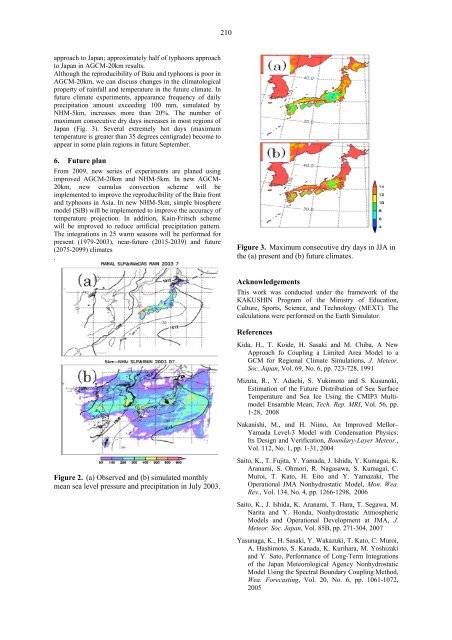Low (web) Quality - BALTEX
Low (web) Quality - BALTEX
Low (web) Quality - BALTEX
You also want an ePaper? Increase the reach of your titles
YUMPU automatically turns print PDFs into web optimized ePapers that Google loves.
210<br />
approach to Japan; approximately half of typhoons approach<br />
to Japan in AGCM-20km results.<br />
Although the reproducibility of Baiu and typhoons is poor in<br />
AGCM-20km, we can discuss changes in the climatological<br />
property of rainfall and temperature in the future climate. In<br />
future climate experiments, appearance frequency of daily<br />
precipitation amount exceeding 100 mm, simulated by<br />
NHM-5km, increases more than 20%. The number of<br />
maximum consecutive dry days increases in most regions of<br />
Japan (Fig. 3). Several extremely hot days (maximum<br />
temperature is greater than 35 degrees centigrade) become to<br />
appear in some plain regions in future September.<br />
6. Future plan<br />
From 2009, new series of experiments are planed using<br />
improved AGCM-20km and NHM-5km. In new AGCM-<br />
20km, new cumulus convection scheme will be<br />
implemented to improve the reproducibility of the Baiu front<br />
and typhoons in Asia. In new NHM-5km, simple biosphere<br />
model (SiB) will be implemented to improve the accuracy of<br />
temperature projection. In addition, Kain-Fritsch scheme<br />
will be improved to reduce artificial precipitation pattern.<br />
The integrations in 25 warm seasons will be performed for<br />
present (1979-2003), near-future (2015-2039) and future<br />
(2075-2099) climates<br />
.<br />
Figure 3. Maximum consecutive dry days in JJA in<br />
the (a) present and (b) future climates.<br />
Acknowledgements<br />
This work was conducted under the framework of the<br />
KAKUSHIN Program of the Ministry of Education,<br />
Culture, Sports, Science, and Technology (MEXT). The<br />
calculations were performed on the Earth Simulator.<br />
References<br />
Kida, H., T. Koide, H. Sasaki and M. Chiba, A New<br />
Approach fo Coupling a Limited Area Model to a<br />
GCM for Regional Climate Simulations, J. Meteor.<br />
Soc. Japan, Vol. 69, No. 6, pp. 723-728, 1991<br />
Mizuta, R., Y. Adachi, S. Yukimoto and S. Kusunoki,<br />
Estimation of the Future Distribution of Sea Surface<br />
Temperature and Sea Ice Using the CMIP3 Multimodel<br />
Ensamble Mean, Tech. Rep. MRI, Vol. 56, pp.<br />
1-28, 2008<br />
Nakanishi, M., and H. Niino, An Improved Mellor–<br />
Yamada Level-3 Model with Condensation Physics:<br />
Its Design and Verification, Boundary-Layer Meteor.,<br />
Vol. 112, No. 1, pp. 1-31, 2004<br />
Figure 2. (a) Observed and (b) simulated monthly<br />
mean sea level pressure and precipitation in July 2003.<br />
Saito, K., T. Fujita, Y. Yamada, J. Ishida, Y. Kumagai, K.<br />
Aranami, S. Ohmori, R. Nagasawa, S. Kumagai, C.<br />
Muroi, T. Kato, H. Eito and Y. Yamazaki, The<br />
Operational JMA Nonhydrostatic Model, Mon. Wea.<br />
Rev., Vol. 134, No. 4, pp. 1266-1298, 2006<br />
Saito, K., J. Ishida, K. Aranami, T. Hara, T. Segawa, M.<br />
Narita and Y. Honda, Nonhydrostatic Atmospheric<br />
Models and Operational Development at JMA, J.<br />
Meteor. Soc. Japan, Vol. 85B, pp. 271-304, 2007<br />
Yasunaga, K., H. Sasaki, Y. Wakazuki, T. Kato, C. Muroi,<br />
A. Hashimoto, S. Kanada, K. Kurihara, M. Yoshizaki<br />
and Y. Sato, Performance of Long-Term Integrations<br />
of the Japan Meteorological Agency Nonhydrostatic<br />
Model Using the Spectral Boundary Coupling Method,<br />
Wea. Forecasting, Vol. 20, No. 6, pp. 1061-1072,<br />
2005













